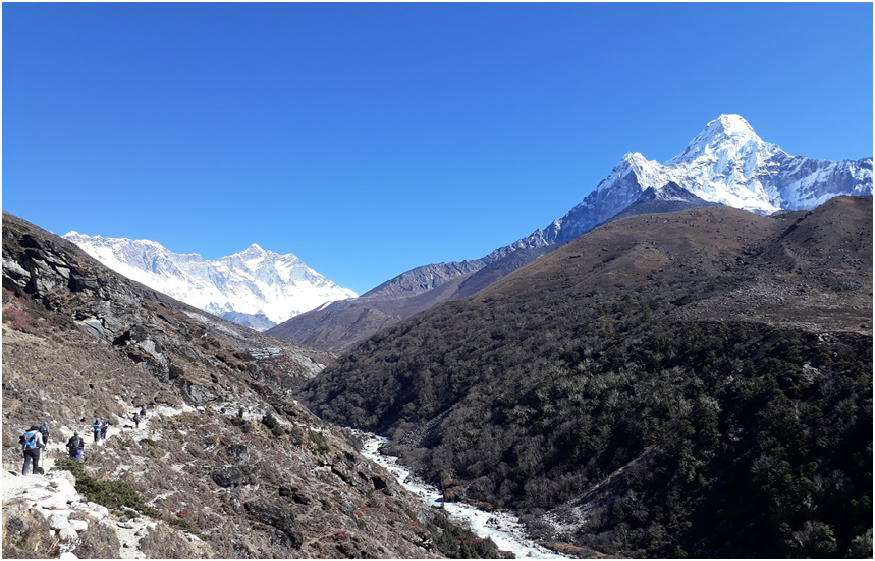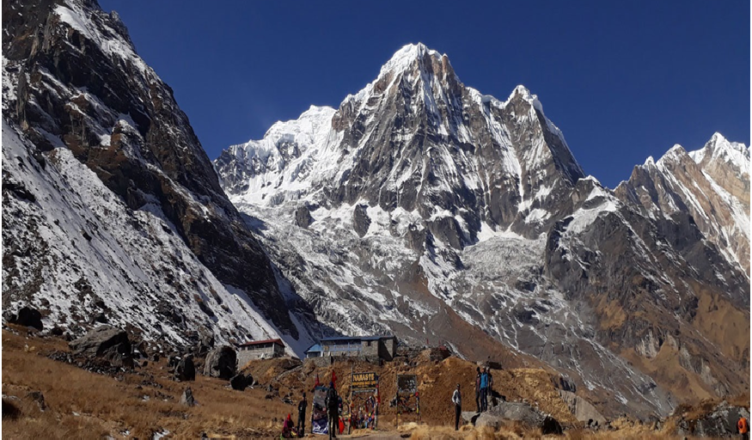
For travelers looking for a challenge, a breathtaking view, and social drenching, Nepal’s peaks offer unparalleled openings. Among the most notorious peaks for climbers are Lobuche Peak, Ama Dablam, Pisang Peak, Yala Peak, and Tent Peak. Whether you’re a prepared mountain climber or a fledgling energetic to handle your to-begin-with trekking peak, these goals have a place on each climber’s bucket list. This directly investigates the highlights, challenges, and rewards of climbing these radiant peaks.
Lobuche Peak Climbing: A Door to Everest
Located in the Everest locale, Lobuche Peak climb (6,119 m / 20,075 ft) is a prevalent choice for climbers looking to experience the magnificence of the Himalayas without committing to an expedition-level climb. It highlights two fundamental summits: Lobuche East and Lobuche West, with the previous being more open to climbers. The peak offers shocking views of Everest, Lhotse, Nuptse, and Ama Dablam, making it a photographer’s dream.
Why Select Lobuche Peak?
Perfect for middle climbers looking for a challenge.
Provides acclimatization openings for those endeavoring Everest or other high-altitude peaks.
Combines specialized climbing with a fulfilling trekking involvement through the Khumbu Valley.
Challenges and Preparation
Lobuche Peak requires fundamental mountaineering aptitudes, counting the use of crampons, ice tomahawks, and settled ropes. The climb includes some segments of snow and ice, particularly close to the summit edge. Physical wellness and earlier trekking involvement are basic for an effective ascent.
Ama Dablam Endeavor: The Gem of the Himalayas
Why Ama Dablam Is Legendary
Ama Dablam (6,812 m / 22,349 ft) is regularly called the “Matterhorn of the Himalayas” due to its emotional, pyramid-like structure. Found in the Everest locale, it is a favorite among experienced climbers. The title “Ama Dablam” deciphers to “Mother’s Accessory,” referencing the peak’s one-of-a-kind hanging ice sheet that takes after a pendant.
What to Expect
The Ama Dablam undertaking is in fact requesting, requiring climbers to explore shake, ice, and blended landscape. The climb is partitioned into three primary camps over the base camp, with soak pitches and uncovered edges driving to the summit. Climbers are compensated with unparalleled views of Everest, Lhotse, and Makalu.
Preparation and Aptitudes Needed
Ama Dablam climb requests advanced climbing abilities and encounters on specialized territory. Climbers ought to be capable of utilizing settled ropes, rising soak ice, and overseeing precipice risks. Pre-expedition preparation and acclimatization climbs, such as Lobuche Peak, are profoundly recommended.
Pisang Peak Climbing: Experience in the Annapurna Region
Introduction to Pisang Peak
Pisang peak climb (6,091 m / 19,984 ft) is one of the most well-known trekking peaks in the Annapurna locale. Its area close to the Annapurna Circuit makes it available to trekkers looking to include a climbing challenge in their travel. The climb is known for its differing territory, which incorporates rough trails, snowfields, and ridges.
Why Pisang Peak Is Culminate for Beginners
Moderate specialized trouble, making it perfect for first-time climbers.
Stunning views of Annapurna II, III, IV, and other peaks in the Annapurna range.
A social travel through conventional Gurung and Thakali villages.
The Climbing Experience
Climbers regularly set up a base camp at 4,380 meters and a tall camp at 5,400 meters. The last climb includes a steep snow incline and edge driving to the summit. Whereas not requesting, the climb requires perseverance and fundamental mountaineering skills.
Yala Peak Climbing: The Most Straightforward Himalayan Summit
A Beginner-Friendly Adventure
Yala Peak (5,520 m / 18,110 ft) is arranged in the Langtang locale, making it one of the most available trekking peaks in Nepal. Its non-technical nature and moderately high height make it a great choice for apprentices looking for their first Himalayan summit.
Highlights of the Yala Peak Climbing
- Stunning views of Shishapangma (8,013 m), one of the world’s fourteen eight-thousanders, found in Tibet.
- A social journey through the Langtang Valley, home to Tamang communities and old monasteries.
Gentle climbing territory that requires negligible specialized skills.
The Climbing Process
The journey to Yala Peak begins with travel to Syabrubesi, followed by a few days of trekking through the Langtang Valley to reach Kyanjin Gompa. Climbers set up base camp at 4,800 meters, with the summit day including a clear climb over snow and rocks.
Tent Peak Climbing: The Covered-up Jewel of Annapurna Sanctuary
An Underrated Trekking Peak
Tent peak climb, moreover known as Tharpu Chuli (5,663 m / 18,575 ft), is found in the Annapurna Haven. It is encompassed by towering peaks like Annapurna South, Hiunchuli, and Machapuchare, advertising a special point of view of the Annapurna range.
What Makes Tent Peak Special?
- Situated inside the Annapurna Asylum, it is a staggering amphitheater of peaks.
- Moderate specialized trouble, reasonable for trekkers transitioning to mountaineering.
- A wealthy social involvement, as the journey passes through Gurung towns and terraced farmlands.
Climbing Details
The journey starts in Nayapul and takes after the Annapurna Base Camp (ABC) course. Climbers set up base camp close to Machapuchare Base Camp sometime recently, rising to tall camp. The last climb includes exploring frosty slants and edges to reach the summit.
Altitude sickness:
Altitude sickness, or Acute Mountain Sickness (AMS), can occur while climbing Pisang Peak, Tent Peak, Lobuche Peak, and Ama Dablam due to reduced oxygen levels at high elevations. The primary cause is the body’s inability to acclimatize to the decrease in oxygen as elevation increases, typically above 2,500 meters.
Prevention:
- Ascend slowly to allow the body time to adjust.
- Acclimatize by resting at intermediate elevations for 1-2 days every 600-900 meters gained.
- Stay hydrated and avoid alcohol or sedatives, which can worsen symptoms.
- Medications like Diamox can help prevent AMS.
First Aid:
- If AMS symptoms (headache, dizziness, nausea, fatigue) occur, descend immediately to a lower elevation.
- Oxygen therapy can help at higher altitudes.
- Rest and avoid further ascent until symptoms improve.
- For severe cases, such as High Altitude Pulmonary Edema (HAPE) or High Altitude Cerebral Edema (HACE), immediate descent and medical evacuation are critical.
Proper preparation, acclimatization, and awareness are key to avoiding altitude sickness.
Best Seasons for Climbing
Spring (March-May): Steady climate, blooming rhododendrons, and clear views.
Autumn (September-November): Fresh discourses, post-monsoon clarity, and perfect temperatures.
Permits and Regulations
Lobuche and Ama Dablam: Sagarmatha National Speak Allow, NMA climbing permits.
Pisang and Tent peaks: Annapurna Preservation Range Allow (ACAP), NMA permits.
Yala Peak: Langtang National Speak Allow and NMA climbing permit.
Physical Preparation
All these climbs require a high level of physical wellness and stamina. Lock in on standard cardiovascular and quality preparation, and hone trekking with a stacked rucksack to mimic genuine conditions.
Equipment
For Simple Sightseeing Tours in Kathmandu and beyond:
- Personal Toiletries are a small day pack or bag to carry your personal belongings such as water bottles, cameras, wallets, maps, journey/notebooks, cell phones, light jackets, or fleece and insect repellent cream as per the season.
- Running /sports shoes or comfortable shoes for short walks, for elderly people walking poles, personal medication, binoculars as an option, T-shirts, long sleeve shirts, trousers (while entering temples and monasteries) sunscreens.
- Sun Hats, Sunglasses, for long drives, soft inflatable cushions/pillows, are advisable options, and rainproof or umbrella.
For Moderate Hikes and Treks:
- Personal Toiletries, a moderate-size daypack to carry your personal belongings such as water bottles, cameras, wallets, maps, journey/notebooks, cell phones, light jackets, or fleece and insect repellent as per the season.
- Running/sports shoes, for elderly people walking poles, personal medication, binoculars an option, T-shirts, long sleeve shirts, trousers (while entering temples and monasteries) sunscreens, and torch/flashlights.
- Sun Hats, Sunglasses, and water bottles are necessary (try to avoid plastic bottled water as they make litter which is hard to recycle in Nepal) use the same waterfalls to refill your bottle where available, rainproof or umbrella. Scarf or mask to avoid dust and smoke.
For long Trekking for a week or more above 3,000 meters:
- Personal Toiletries, a moderate-size day pack or rucksack to carry your personal belongings such as travel documents, water bottles, cameras, wallets, maps, journey/notebooks, cell phones, light jackets, or fleece insect repellent as per the season.
- Running/sports shoes, good pair of boots, warm woolen/cotton socks, snow gaiters, rain/windproof gear, walking poles an option, personal medication, binoculars an option, T-shirts, long sleeve shirts, trousers (while entering temples and monasteries) sunscreens, torch/flashlights.
- Gloves, Woolen Beni (camp) Sun Hats, Sun/snow glasses, and water bottles are necessary (try to avoid plastic bottled water as they make litter which is hard to recycle in Nepal) use the same waterfalls for refills where available. Scarf or mask to avoid dust and smoke.
- On trekking, bigger kit/duffel bags are carried by porters/pack animals (yaks, mules, or ponies) which include your heavy personal gear that is sleeping bags, down / duvet jackets, and the items that you do require during daytime on walks till designated campsites/lodge.
Conclusion: A Bucket List Worth Pursuing
Climbing Lobuche Peak, Ama Dablam, Pisang Peak, Yala Peak, and Tent Peak is more than a fair physical challenge—it’s a trip into the heart of Nepal’s dazzling scenes and dynamic societies. Whether you’re drawn to the specialized thrills of Ama Dablam or the beginner-friendly inclines of Yala Peak, these climbs offer something for each explorer. Begin arranging your endeavor nowadays, and let the Himalayas change your dreams into reality.
Contact Us Team Himalaya For More Info
Team Himalaya Pvt. Ltd. is a trusted local trekking company based in Kathmandu, Nepal. We specialize in organizing multi-day tours, treks, climbing adventures, expeditions, and other related activities for solo travelers and private groups. Our services extend across Nepal, Bhutan, and Tibet.
For inquiries, feel free to reach out to us at [email protected] or via Whatsapp at +9779841824281.

